Aspects of Contract & Negligence
VerifiedAdded on 2020/02/05
|12
|4616
|46
Report
AI Summary
This report comprehensively analyzes aspects of contract and negligence law, crucial for business understanding. It details elements of a valid contract (offer, acceptance, consideration, capacity, lawful object), explores different contract types (bilateral, unilateral, under seal, simple, written, verbal, face-to-face, distance selling), and examines contractual terms (express, implied, innominate, conditions, warranties, exclusion clauses). The report further investigates negligence, outlining its elements (duty of care, breach of duty, direct cause, remoteness of damage) and explaining vicarious liability. Case studies of Abel, Eric, and Denis illustrate the application of these legal principles, highlighting the implications of contract breaches and negligence in real-world scenarios. The conclusion emphasizes the distinct nature of contract and tort law, showcasing their relevance in business contexts and the potential liabilities involved.
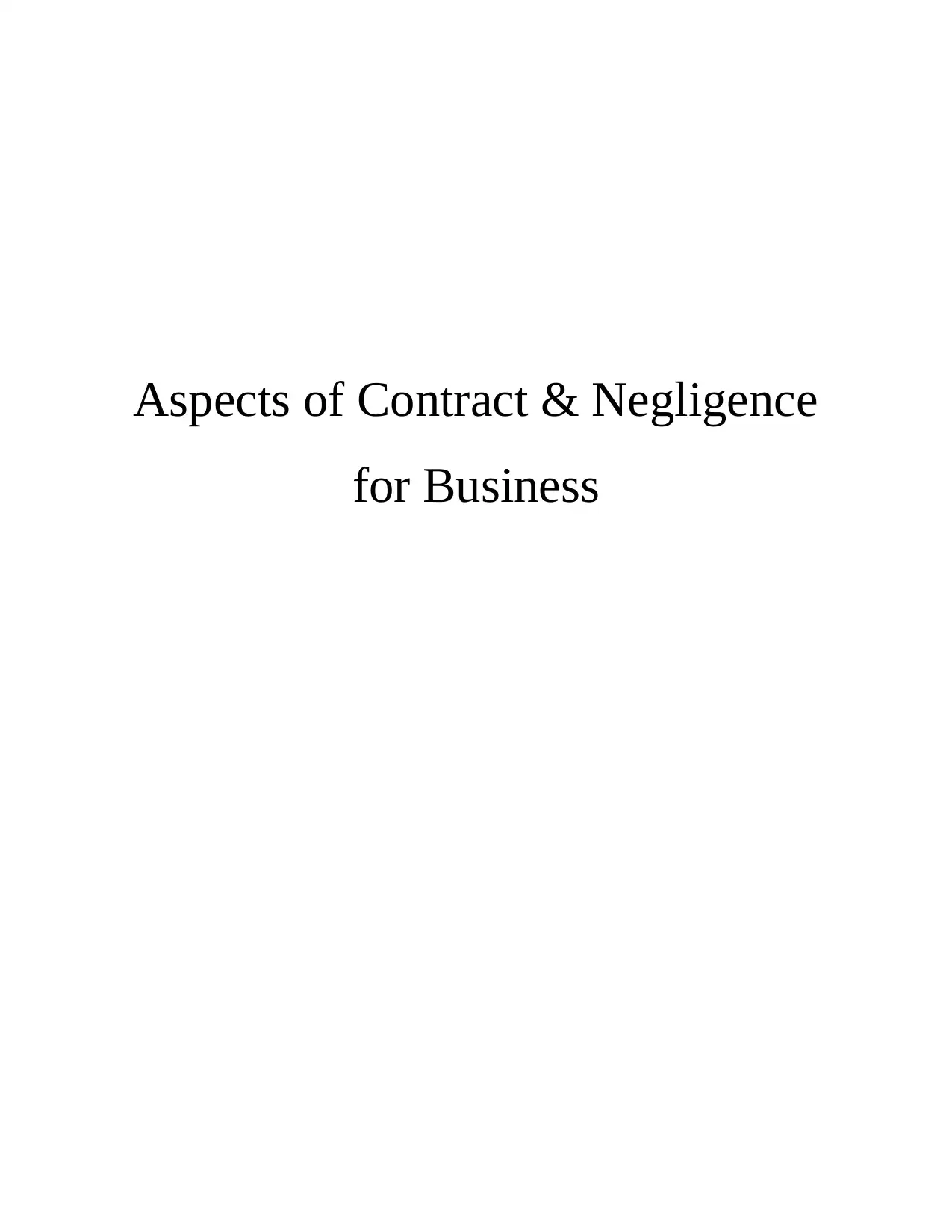
Aspects of Contract & Negligence
for Business
for Business
Paraphrase This Document
Need a fresh take? Get an instant paraphrase of this document with our AI Paraphraser
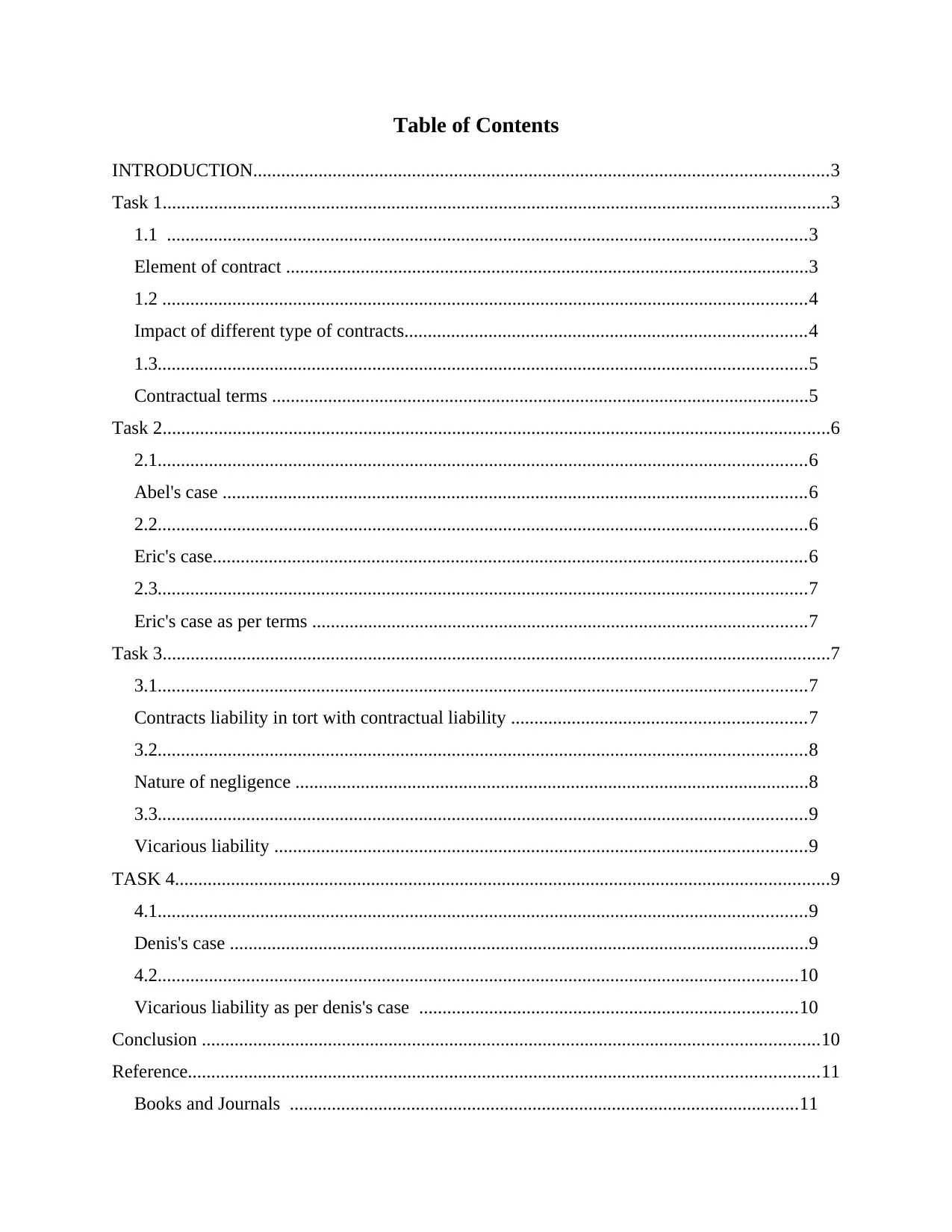
Table of Contents
INTRODUCTION...........................................................................................................................3
Task 1...............................................................................................................................................3
1.1 .........................................................................................................................................3
Element of contract ................................................................................................................3
1.2 ..........................................................................................................................................4
Impact of different type of contracts......................................................................................4
1.3...........................................................................................................................................5
Contractual terms ...................................................................................................................5
Task 2...............................................................................................................................................6
2.1...........................................................................................................................................6
Abel's case .............................................................................................................................6
2.2...........................................................................................................................................6
Eric's case...............................................................................................................................6
2.3...........................................................................................................................................7
Eric's case as per terms ..........................................................................................................7
Task 3...............................................................................................................................................7
3.1...........................................................................................................................................7
Contracts liability in tort with contractual liability ...............................................................7
3.2...........................................................................................................................................8
Nature of negligence ..............................................................................................................8
3.3...........................................................................................................................................9
Vicarious liability ..................................................................................................................9
TASK 4............................................................................................................................................9
4.1...........................................................................................................................................9
Denis's case ............................................................................................................................9
4.2.........................................................................................................................................10
Vicarious liability as per denis's case .................................................................................10
Conclusion ....................................................................................................................................10
Reference.......................................................................................................................................11
Books and Journals .............................................................................................................11
INTRODUCTION...........................................................................................................................3
Task 1...............................................................................................................................................3
1.1 .........................................................................................................................................3
Element of contract ................................................................................................................3
1.2 ..........................................................................................................................................4
Impact of different type of contracts......................................................................................4
1.3...........................................................................................................................................5
Contractual terms ...................................................................................................................5
Task 2...............................................................................................................................................6
2.1...........................................................................................................................................6
Abel's case .............................................................................................................................6
2.2...........................................................................................................................................6
Eric's case...............................................................................................................................6
2.3...........................................................................................................................................7
Eric's case as per terms ..........................................................................................................7
Task 3...............................................................................................................................................7
3.1...........................................................................................................................................7
Contracts liability in tort with contractual liability ...............................................................7
3.2...........................................................................................................................................8
Nature of negligence ..............................................................................................................8
3.3...........................................................................................................................................9
Vicarious liability ..................................................................................................................9
TASK 4............................................................................................................................................9
4.1...........................................................................................................................................9
Denis's case ............................................................................................................................9
4.2.........................................................................................................................................10
Vicarious liability as per denis's case .................................................................................10
Conclusion ....................................................................................................................................10
Reference.......................................................................................................................................11
Books and Journals .............................................................................................................11
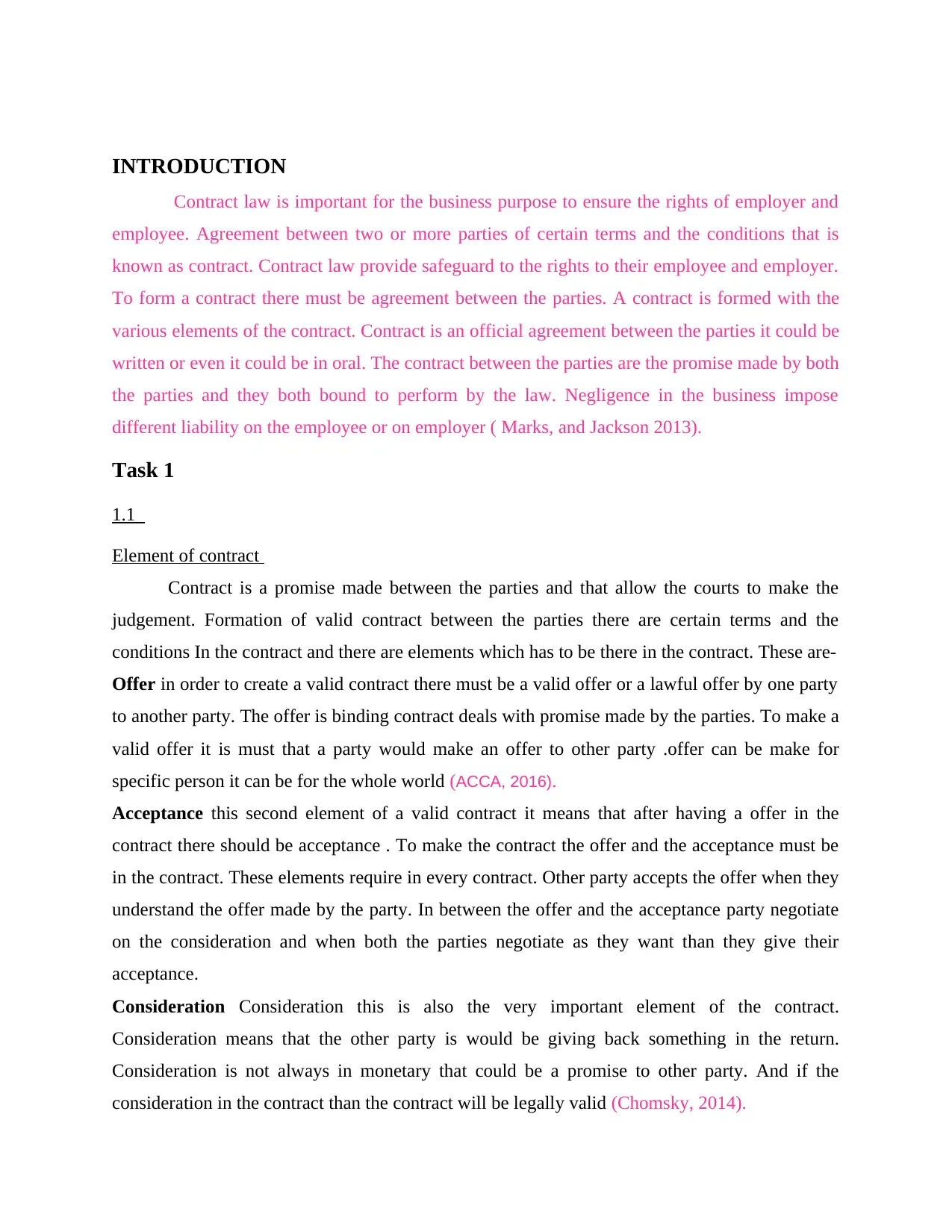
INTRODUCTION
Contract law is important for the business purpose to ensure the rights of employer and
employee. Agreement between two or more parties of certain terms and the conditions that is
known as contract. Contract law provide safeguard to the rights to their employee and employer.
To form a contract there must be agreement between the parties. A contract is formed with the
various elements of the contract. Contract is an official agreement between the parties it could be
written or even it could be in oral. The contract between the parties are the promise made by both
the parties and they both bound to perform by the law. Negligence in the business impose
different liability on the employee or on employer ( Marks, and Jackson 2013).
Task 1
1.1
Element of contract
Contract is a promise made between the parties and that allow the courts to make the
judgement. Formation of valid contract between the parties there are certain terms and the
conditions In the contract and there are elements which has to be there in the contract. These are-
Offer in order to create a valid contract there must be a valid offer or a lawful offer by one party
to another party. The offer is binding contract deals with promise made by the parties. To make a
valid offer it is must that a party would make an offer to other party .offer can be make for
specific person it can be for the whole world (ACCA, 2016).
Acceptance this second element of a valid contract it means that after having a offer in the
contract there should be acceptance . To make the contract the offer and the acceptance must be
in the contract. These elements require in every contract. Other party accepts the offer when they
understand the offer made by the party. In between the offer and the acceptance party negotiate
on the consideration and when both the parties negotiate as they want than they give their
acceptance.
Consideration Consideration this is also the very important element of the contract.
Consideration means that the other party is would be giving back something in the return.
Consideration is not always in monetary that could be a promise to other party. And if the
consideration in the contract than the contract will be legally valid (Chomsky, 2014).
Contract law is important for the business purpose to ensure the rights of employer and
employee. Agreement between two or more parties of certain terms and the conditions that is
known as contract. Contract law provide safeguard to the rights to their employee and employer.
To form a contract there must be agreement between the parties. A contract is formed with the
various elements of the contract. Contract is an official agreement between the parties it could be
written or even it could be in oral. The contract between the parties are the promise made by both
the parties and they both bound to perform by the law. Negligence in the business impose
different liability on the employee or on employer ( Marks, and Jackson 2013).
Task 1
1.1
Element of contract
Contract is a promise made between the parties and that allow the courts to make the
judgement. Formation of valid contract between the parties there are certain terms and the
conditions In the contract and there are elements which has to be there in the contract. These are-
Offer in order to create a valid contract there must be a valid offer or a lawful offer by one party
to another party. The offer is binding contract deals with promise made by the parties. To make a
valid offer it is must that a party would make an offer to other party .offer can be make for
specific person it can be for the whole world (ACCA, 2016).
Acceptance this second element of a valid contract it means that after having a offer in the
contract there should be acceptance . To make the contract the offer and the acceptance must be
in the contract. These elements require in every contract. Other party accepts the offer when they
understand the offer made by the party. In between the offer and the acceptance party negotiate
on the consideration and when both the parties negotiate as they want than they give their
acceptance.
Consideration Consideration this is also the very important element of the contract.
Consideration means that the other party is would be giving back something in the return.
Consideration is not always in monetary that could be a promise to other party. And if the
consideration in the contract than the contract will be legally valid (Chomsky, 2014).
⊘ This is a preview!⊘
Do you want full access?
Subscribe today to unlock all pages.

Trusted by 1+ million students worldwide
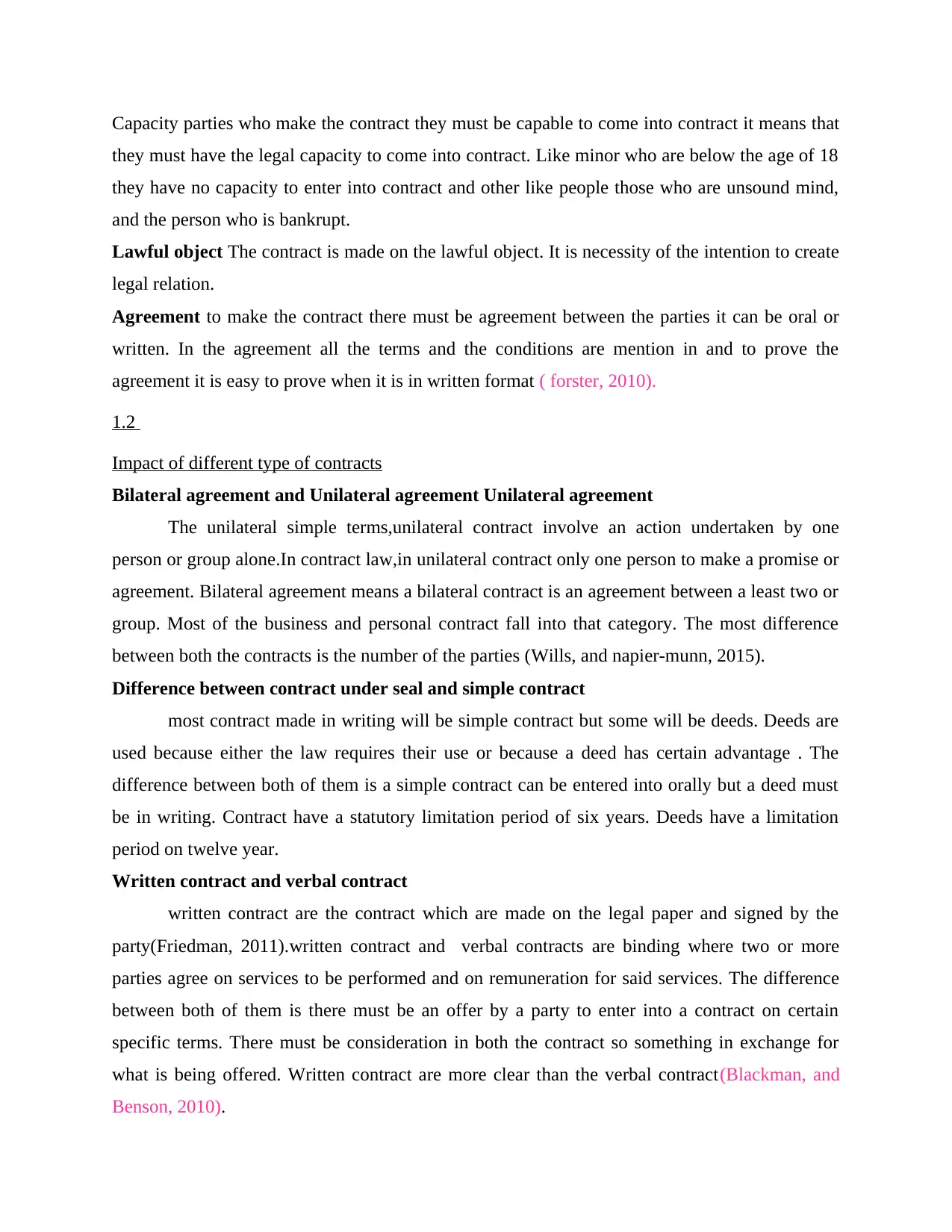
Capacity parties who make the contract they must be capable to come into contract it means that
they must have the legal capacity to come into contract. Like minor who are below the age of 18
they have no capacity to enter into contract and other like people those who are unsound mind,
and the person who is bankrupt.
Lawful object The contract is made on the lawful object. It is necessity of the intention to create
legal relation.
Agreement to make the contract there must be agreement between the parties it can be oral or
written. In the agreement all the terms and the conditions are mention in and to prove the
agreement it is easy to prove when it is in written format ( forster, 2010).
1.2
Impact of different type of contracts
Bilateral agreement and Unilateral agreement Unilateral agreement
The unilateral simple terms,unilateral contract involve an action undertaken by one
person or group alone.In contract law,in unilateral contract only one person to make a promise or
agreement. Bilateral agreement means a bilateral contract is an agreement between a least two or
group. Most of the business and personal contract fall into that category. The most difference
between both the contracts is the number of the parties (Wills, and napier-munn, 2015).
Difference between contract under seal and simple contract
most contract made in writing will be simple contract but some will be deeds. Deeds are
used because either the law requires their use or because a deed has certain advantage . The
difference between both of them is a simple contract can be entered into orally but a deed must
be in writing. Contract have a statutory limitation period of six years. Deeds have a limitation
period on twelve year.
Written contract and verbal contract
written contract are the contract which are made on the legal paper and signed by the
party(Friedman, 2011).written contract and verbal contracts are binding where two or more
parties agree on services to be performed and on remuneration for said services. The difference
between both of them is there must be an offer by a party to enter into a contract on certain
specific terms. There must be consideration in both the contract so something in exchange for
what is being offered. Written contract are more clear than the verbal contract(Blackman, and
Benson, 2010).
they must have the legal capacity to come into contract. Like minor who are below the age of 18
they have no capacity to enter into contract and other like people those who are unsound mind,
and the person who is bankrupt.
Lawful object The contract is made on the lawful object. It is necessity of the intention to create
legal relation.
Agreement to make the contract there must be agreement between the parties it can be oral or
written. In the agreement all the terms and the conditions are mention in and to prove the
agreement it is easy to prove when it is in written format ( forster, 2010).
1.2
Impact of different type of contracts
Bilateral agreement and Unilateral agreement Unilateral agreement
The unilateral simple terms,unilateral contract involve an action undertaken by one
person or group alone.In contract law,in unilateral contract only one person to make a promise or
agreement. Bilateral agreement means a bilateral contract is an agreement between a least two or
group. Most of the business and personal contract fall into that category. The most difference
between both the contracts is the number of the parties (Wills, and napier-munn, 2015).
Difference between contract under seal and simple contract
most contract made in writing will be simple contract but some will be deeds. Deeds are
used because either the law requires their use or because a deed has certain advantage . The
difference between both of them is a simple contract can be entered into orally but a deed must
be in writing. Contract have a statutory limitation period of six years. Deeds have a limitation
period on twelve year.
Written contract and verbal contract
written contract are the contract which are made on the legal paper and signed by the
party(Friedman, 2011).written contract and verbal contracts are binding where two or more
parties agree on services to be performed and on remuneration for said services. The difference
between both of them is there must be an offer by a party to enter into a contract on certain
specific terms. There must be consideration in both the contract so something in exchange for
what is being offered. Written contract are more clear than the verbal contract(Blackman, and
Benson, 2010).
Paraphrase This Document
Need a fresh take? Get an instant paraphrase of this document with our AI Paraphraser

Face to face contract and Distance selling contract
As per the face to face contract when both the parties were present at same place than
they can come into this contract. These contract at are known as crystal clear contract.
Distance selling contract are the contract between the parties when buyer and the seller both are
the distance to each other. in distance selling Contract parties sell or buy their product through
phone email or by internet. Difference between both of them is in face to face contract there are
less chances of misunderstanding in distance selling contract there are chances more chance of
fraud (Blomme, Van Rheede, and Tromp, 2010).
1.3
Contractual terms
To understand the contract there are terms in the contract. In the contract there are terms
in the contract. There are three terms in the contract.
Express contract these terms are express by the parties themselves. These terms are on the party
agrees. These terms are on the contract is made. The purpose of the contract is describe by the
express terms.
Implied terms these terms are describe by the court or by the statute. These terms are included
by the courts or by the statute for the proper enforcement of the contract. These term also include
the statutory rights of the parties which are equal pay and the maternity leaves in the employment
(LawTeacher, 2017).
Innominate terms these terms are neither include in express nor in implied terms. And it can be
either condition or warranties. Breach of them can be serious or trivial depending on particular
fact situation. Condition These are the most important terms of contract. Serious consequences if
breeched.
Conditions are the major terms in the contract that major affect in the breach of the contract.
other party have power to terminate the contract.
Warranties are the small terms in the contract if that is breached by the party than other party can
ask for the compensation for his damage.
Exclusion terms are the terms in the contract which give a limit the liability of one party. As per
the limiting term of the exclusion clause that limit the amount of the damage so that limit the
liability of the one party (Worksmart , 2016.). Such clauses are valid only when these are properly
included in the contract and are not contrary to law. These legal rules are explained below :
As per the face to face contract when both the parties were present at same place than
they can come into this contract. These contract at are known as crystal clear contract.
Distance selling contract are the contract between the parties when buyer and the seller both are
the distance to each other. in distance selling Contract parties sell or buy their product through
phone email or by internet. Difference between both of them is in face to face contract there are
less chances of misunderstanding in distance selling contract there are chances more chance of
fraud (Blomme, Van Rheede, and Tromp, 2010).
1.3
Contractual terms
To understand the contract there are terms in the contract. In the contract there are terms
in the contract. There are three terms in the contract.
Express contract these terms are express by the parties themselves. These terms are on the party
agrees. These terms are on the contract is made. The purpose of the contract is describe by the
express terms.
Implied terms these terms are describe by the court or by the statute. These terms are included
by the courts or by the statute for the proper enforcement of the contract. These term also include
the statutory rights of the parties which are equal pay and the maternity leaves in the employment
(LawTeacher, 2017).
Innominate terms these terms are neither include in express nor in implied terms. And it can be
either condition or warranties. Breach of them can be serious or trivial depending on particular
fact situation. Condition These are the most important terms of contract. Serious consequences if
breeched.
Conditions are the major terms in the contract that major affect in the breach of the contract.
other party have power to terminate the contract.
Warranties are the small terms in the contract if that is breached by the party than other party can
ask for the compensation for his damage.
Exclusion terms are the terms in the contract which give a limit the liability of one party. As per
the limiting term of the exclusion clause that limit the amount of the damage so that limit the
liability of the one party (Worksmart , 2016.). Such clauses are valid only when these are properly
included in the contract and are not contrary to law. These legal rules are explained below :
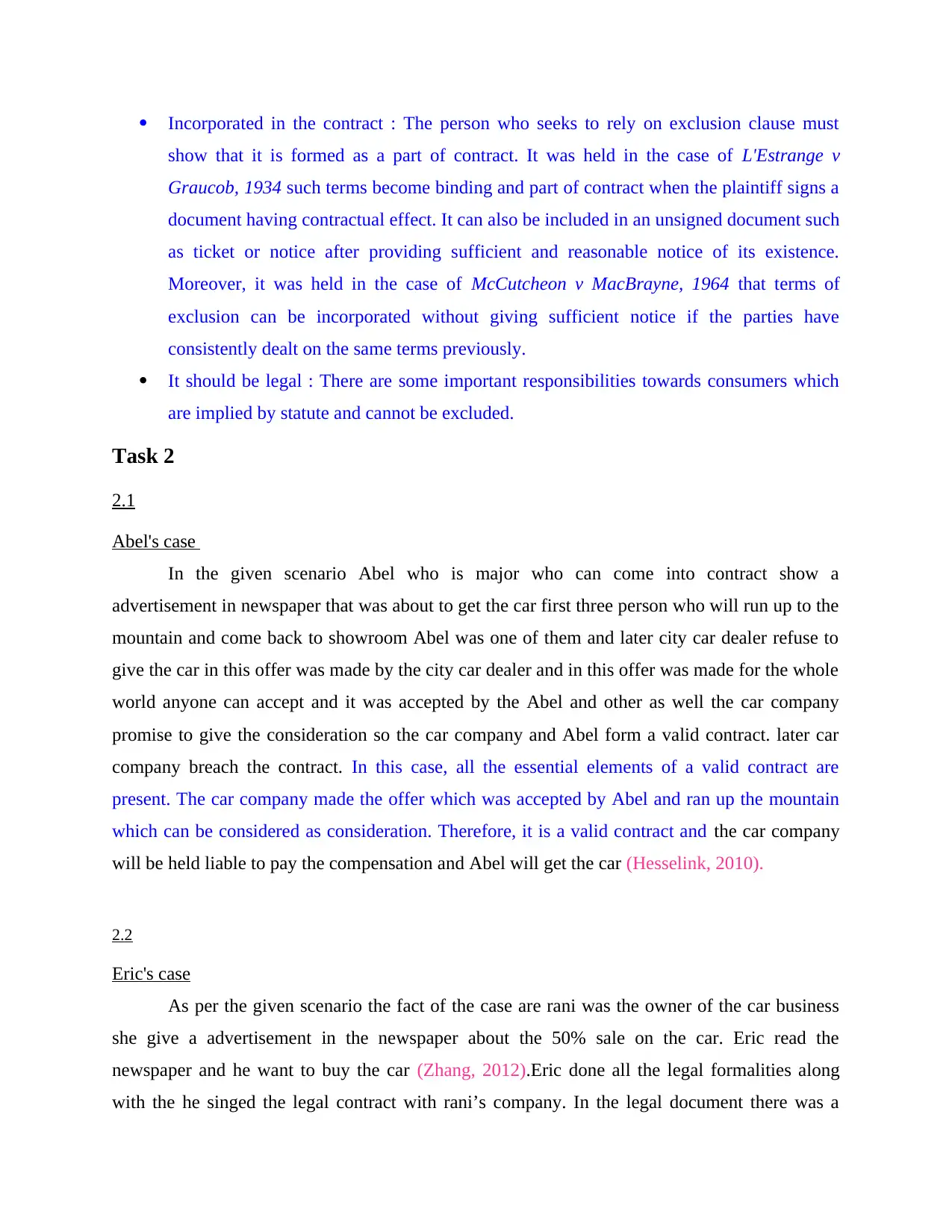
Incorporated in the contract : The person who seeks to rely on exclusion clause must
show that it is formed as a part of contract. It was held in the case of L'Estrange v
Graucob, 1934 such terms become binding and part of contract when the plaintiff signs a
document having contractual effect. It can also be included in an unsigned document such
as ticket or notice after providing sufficient and reasonable notice of its existence.
Moreover, it was held in the case of McCutcheon v MacBrayne, 1964 that terms of
exclusion can be incorporated without giving sufficient notice if the parties have
consistently dealt on the same terms previously.
It should be legal : There are some important responsibilities towards consumers which
are implied by statute and cannot be excluded.
Task 2
2.1
Abel's case
In the given scenario Abel who is major who can come into contract show a
advertisement in newspaper that was about to get the car first three person who will run up to the
mountain and come back to showroom Abel was one of them and later city car dealer refuse to
give the car in this offer was made by the city car dealer and in this offer was made for the whole
world anyone can accept and it was accepted by the Abel and other as well the car company
promise to give the consideration so the car company and Abel form a valid contract. later car
company breach the contract. In this case, all the essential elements of a valid contract are
present. The car company made the offer which was accepted by Abel and ran up the mountain
which can be considered as consideration. Therefore, it is a valid contract and the car company
will be held liable to pay the compensation and Abel will get the car (Hesselink, 2010).
2.2
Eric's case
As per the given scenario the fact of the case are rani was the owner of the car business
she give a advertisement in the newspaper about the 50% sale on the car. Eric read the
newspaper and he want to buy the car (Zhang, 2012).Eric done all the legal formalities along
with the he singed the legal contract with rani’s company. In the legal document there was a
show that it is formed as a part of contract. It was held in the case of L'Estrange v
Graucob, 1934 such terms become binding and part of contract when the plaintiff signs a
document having contractual effect. It can also be included in an unsigned document such
as ticket or notice after providing sufficient and reasonable notice of its existence.
Moreover, it was held in the case of McCutcheon v MacBrayne, 1964 that terms of
exclusion can be incorporated without giving sufficient notice if the parties have
consistently dealt on the same terms previously.
It should be legal : There are some important responsibilities towards consumers which
are implied by statute and cannot be excluded.
Task 2
2.1
Abel's case
In the given scenario Abel who is major who can come into contract show a
advertisement in newspaper that was about to get the car first three person who will run up to the
mountain and come back to showroom Abel was one of them and later city car dealer refuse to
give the car in this offer was made by the city car dealer and in this offer was made for the whole
world anyone can accept and it was accepted by the Abel and other as well the car company
promise to give the consideration so the car company and Abel form a valid contract. later car
company breach the contract. In this case, all the essential elements of a valid contract are
present. The car company made the offer which was accepted by Abel and ran up the mountain
which can be considered as consideration. Therefore, it is a valid contract and the car company
will be held liable to pay the compensation and Abel will get the car (Hesselink, 2010).
2.2
Eric's case
As per the given scenario the fact of the case are rani was the owner of the car business
she give a advertisement in the newspaper about the 50% sale on the car. Eric read the
newspaper and he want to buy the car (Zhang, 2012).Eric done all the legal formalities along
with the he singed the legal contract with rani’s company. In the legal document there was a
⊘ This is a preview!⊘
Do you want full access?
Subscribe today to unlock all pages.

Trusted by 1+ million students worldwide
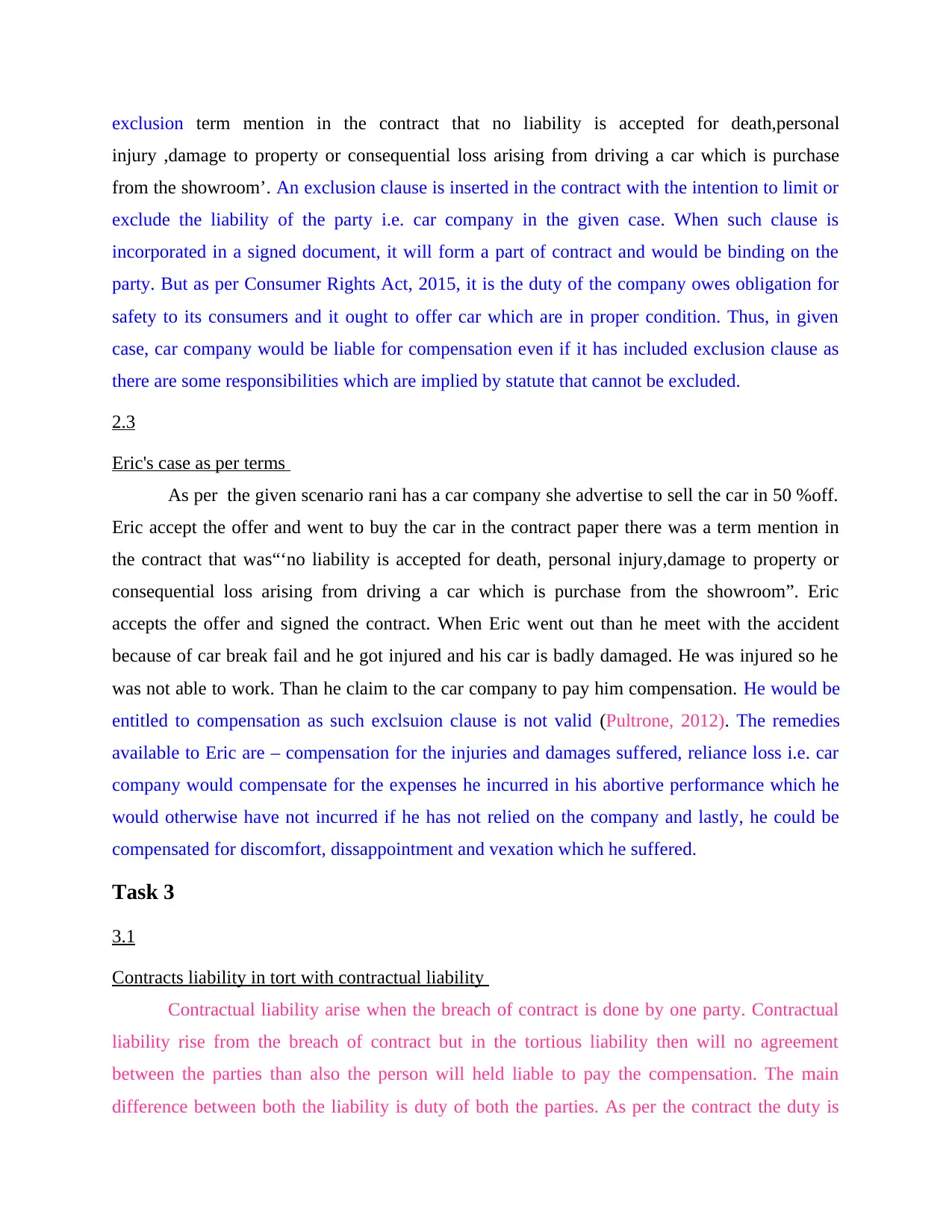
exclusion term mention in the contract that no liability is accepted for death,personal
injury ,damage to property or consequential loss arising from driving a car which is purchase
from the showroom’. An exclusion clause is inserted in the contract with the intention to limit or
exclude the liability of the party i.e. car company in the given case. When such clause is
incorporated in a signed document, it will form a part of contract and would be binding on the
party. But as per Consumer Rights Act, 2015, it is the duty of the company owes obligation for
safety to its consumers and it ought to offer car which are in proper condition. Thus, in given
case, car company would be liable for compensation even if it has included exclusion clause as
there are some responsibilities which are implied by statute that cannot be excluded.
2.3
Eric's case as per terms
As per the given scenario rani has a car company she advertise to sell the car in 50 %off.
Eric accept the offer and went to buy the car in the contract paper there was a term mention in
the contract that was“‘no liability is accepted for death, personal injury,damage to property or
consequential loss arising from driving a car which is purchase from the showroom”. Eric
accepts the offer and signed the contract. When Eric went out than he meet with the accident
because of car break fail and he got injured and his car is badly damaged. He was injured so he
was not able to work. Than he claim to the car company to pay him compensation. He would be
entitled to compensation as such exclsuion clause is not valid (Pultrone, 2012). The remedies
available to Eric are – compensation for the injuries and damages suffered, reliance loss i.e. car
company would compensate for the expenses he incurred in his abortive performance which he
would otherwise have not incurred if he has not relied on the company and lastly, he could be
compensated for discomfort, dissappointment and vexation which he suffered.
Task 3
3.1
Contracts liability in tort with contractual liability
Contractual liability arise when the breach of contract is done by one party. Contractual
liability rise from the breach of contract but in the tortious liability then will no agreement
between the parties than also the person will held liable to pay the compensation. The main
difference between both the liability is duty of both the parties. As per the contract the duty is
injury ,damage to property or consequential loss arising from driving a car which is purchase
from the showroom’. An exclusion clause is inserted in the contract with the intention to limit or
exclude the liability of the party i.e. car company in the given case. When such clause is
incorporated in a signed document, it will form a part of contract and would be binding on the
party. But as per Consumer Rights Act, 2015, it is the duty of the company owes obligation for
safety to its consumers and it ought to offer car which are in proper condition. Thus, in given
case, car company would be liable for compensation even if it has included exclusion clause as
there are some responsibilities which are implied by statute that cannot be excluded.
2.3
Eric's case as per terms
As per the given scenario rani has a car company she advertise to sell the car in 50 %off.
Eric accept the offer and went to buy the car in the contract paper there was a term mention in
the contract that was“‘no liability is accepted for death, personal injury,damage to property or
consequential loss arising from driving a car which is purchase from the showroom”. Eric
accepts the offer and signed the contract. When Eric went out than he meet with the accident
because of car break fail and he got injured and his car is badly damaged. He was injured so he
was not able to work. Than he claim to the car company to pay him compensation. He would be
entitled to compensation as such exclsuion clause is not valid (Pultrone, 2012). The remedies
available to Eric are – compensation for the injuries and damages suffered, reliance loss i.e. car
company would compensate for the expenses he incurred in his abortive performance which he
would otherwise have not incurred if he has not relied on the company and lastly, he could be
compensated for discomfort, dissappointment and vexation which he suffered.
Task 3
3.1
Contracts liability in tort with contractual liability
Contractual liability arise when the breach of contract is done by one party. Contractual
liability rise from the breach of contract but in the tortious liability then will no agreement
between the parties than also the person will held liable to pay the compensation. The main
difference between both the liability is duty of both the parties. As per the contract the duty is
Paraphrase This Document
Need a fresh take? Get an instant paraphrase of this document with our AI Paraphraser

impose as per the given conditions in the agreement and in the tortious liability the duty is fixed
by the law of tort (Molderez, and Janssens, 2012).A tort is an act that injures someone in some
way,and for which the injured person may sue the wrongdoer for damages. So,it may be stated
that “ Tortious liability arises from the breach of a duty primarily fixed by law, this duty is
towards the persons generally and its breach is addressed by law by an action for unvalidated
damages. As per the tort law the liability impose by the the law of tort and that is compulsory
obligation arise on the parties. Contract law liability is voluntary taken by the parties. One other
contrast between liability in contract and tort is observed in the nature of damages under each. In
contract the plaintiff claims liquidated damages whereas in tort unvalidated damages are
claimed. Tort can impose the strict liability on the parties and in the contract liability will be as
per the breach of the contract.
3.2
Nature of negligence
These are the elements in the negligence which are
Duty to care to prove the negligence on the defendant it has to see that the duty impose
on the defendant or not. This doctrine duty to care means this is dictates the certain circumstance
which one party will be liable to another for the negligence. The duty of care also define that
whether the duty is impose on the defendant or not and if he have duty toward the other party
than he will liable for the negligence. To prove the duty on the there are certain test for imposing
the duty care according to the type of loss which cause to plaintiff. For the personal injury and
for damage of property that was introduce in the case donoghue v. stevenson in this the modern
negligence is introduce by the lord Atkin's in this case the duty of care was breached by the one
party this case is very well known as snail in the bottle case. Therefore it is necessary for the
claimant to establish that the defendant owed them a duty of care.
Breach of duty to prove the negligence in the case there has to be breach of the duty
cause by the defendant that only plaintiff will be entitle to get the compensation. Breach of duty
require defendant to have been at fault by not fulling his duty toward the plaintiff. To prove the
breach of duty there are two test apply by the court first is a question of law that define duty care
of the defendant should have exercise and that is proved by the law that defendant fulfil his duty
which was impose on plaintiff than he will not entitle to pay any compensation. And the second
question of fact that ask , whether the defendant's conduct was below the requirement of the
by the law of tort (Molderez, and Janssens, 2012).A tort is an act that injures someone in some
way,and for which the injured person may sue the wrongdoer for damages. So,it may be stated
that “ Tortious liability arises from the breach of a duty primarily fixed by law, this duty is
towards the persons generally and its breach is addressed by law by an action for unvalidated
damages. As per the tort law the liability impose by the the law of tort and that is compulsory
obligation arise on the parties. Contract law liability is voluntary taken by the parties. One other
contrast between liability in contract and tort is observed in the nature of damages under each. In
contract the plaintiff claims liquidated damages whereas in tort unvalidated damages are
claimed. Tort can impose the strict liability on the parties and in the contract liability will be as
per the breach of the contract.
3.2
Nature of negligence
These are the elements in the negligence which are
Duty to care to prove the negligence on the defendant it has to see that the duty impose
on the defendant or not. This doctrine duty to care means this is dictates the certain circumstance
which one party will be liable to another for the negligence. The duty of care also define that
whether the duty is impose on the defendant or not and if he have duty toward the other party
than he will liable for the negligence. To prove the duty on the there are certain test for imposing
the duty care according to the type of loss which cause to plaintiff. For the personal injury and
for damage of property that was introduce in the case donoghue v. stevenson in this the modern
negligence is introduce by the lord Atkin's in this case the duty of care was breached by the one
party this case is very well known as snail in the bottle case. Therefore it is necessary for the
claimant to establish that the defendant owed them a duty of care.
Breach of duty to prove the negligence in the case there has to be breach of the duty
cause by the defendant that only plaintiff will be entitle to get the compensation. Breach of duty
require defendant to have been at fault by not fulling his duty toward the plaintiff. To prove the
breach of duty there are two test apply by the court first is a question of law that define duty care
of the defendant should have exercise and that is proved by the law that defendant fulfil his duty
which was impose on plaintiff than he will not entitle to pay any compensation. And the second
question of fact that ask , whether the defendant's conduct was below the requirement of the
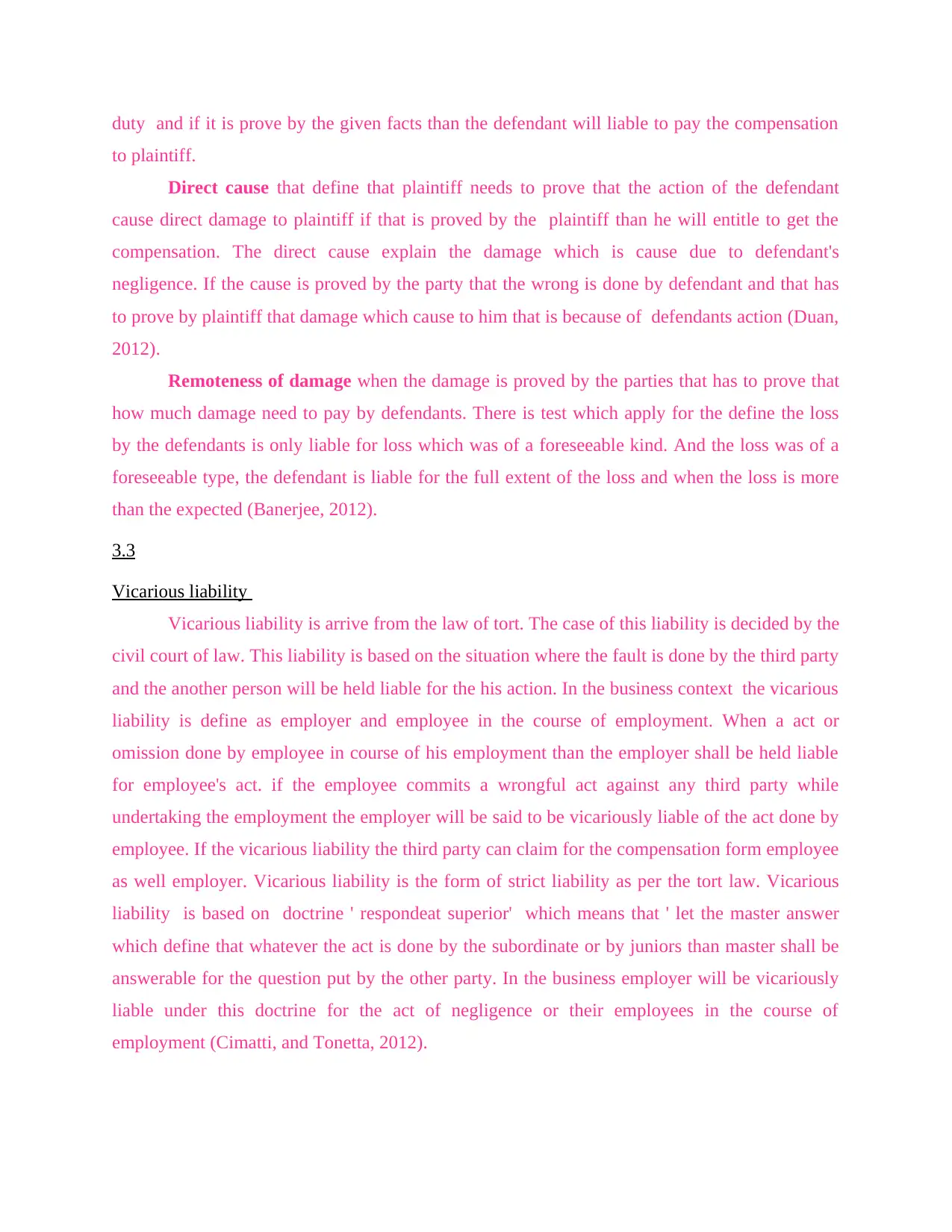
duty and if it is prove by the given facts than the defendant will liable to pay the compensation
to plaintiff.
Direct cause that define that plaintiff needs to prove that the action of the defendant
cause direct damage to plaintiff if that is proved by the plaintiff than he will entitle to get the
compensation. The direct cause explain the damage which is cause due to defendant's
negligence. If the cause is proved by the party that the wrong is done by defendant and that has
to prove by plaintiff that damage which cause to him that is because of defendants action (Duan,
2012).
Remoteness of damage when the damage is proved by the parties that has to prove that
how much damage need to pay by defendants. There is test which apply for the define the loss
by the defendants is only liable for loss which was of a foreseeable kind. And the loss was of a
foreseeable type, the defendant is liable for the full extent of the loss and when the loss is more
than the expected (Banerjee, 2012).
3.3
Vicarious liability
Vicarious liability is arrive from the law of tort. The case of this liability is decided by the
civil court of law. This liability is based on the situation where the fault is done by the third party
and the another person will be held liable for the his action. In the business context the vicarious
liability is define as employer and employee in the course of employment. When a act or
omission done by employee in course of his employment than the employer shall be held liable
for employee's act. if the employee commits a wrongful act against any third party while
undertaking the employment the employer will be said to be vicariously liable of the act done by
employee. If the vicarious liability the third party can claim for the compensation form employee
as well employer. Vicarious liability is the form of strict liability as per the tort law. Vicarious
liability is based on doctrine ' respondeat superior' which means that ' let the master answer
which define that whatever the act is done by the subordinate or by juniors than master shall be
answerable for the question put by the other party. In the business employer will be vicariously
liable under this doctrine for the act of negligence or their employees in the course of
employment (Cimatti, and Tonetta, 2012).
to plaintiff.
Direct cause that define that plaintiff needs to prove that the action of the defendant
cause direct damage to plaintiff if that is proved by the plaintiff than he will entitle to get the
compensation. The direct cause explain the damage which is cause due to defendant's
negligence. If the cause is proved by the party that the wrong is done by defendant and that has
to prove by plaintiff that damage which cause to him that is because of defendants action (Duan,
2012).
Remoteness of damage when the damage is proved by the parties that has to prove that
how much damage need to pay by defendants. There is test which apply for the define the loss
by the defendants is only liable for loss which was of a foreseeable kind. And the loss was of a
foreseeable type, the defendant is liable for the full extent of the loss and when the loss is more
than the expected (Banerjee, 2012).
3.3
Vicarious liability
Vicarious liability is arrive from the law of tort. The case of this liability is decided by the
civil court of law. This liability is based on the situation where the fault is done by the third party
and the another person will be held liable for the his action. In the business context the vicarious
liability is define as employer and employee in the course of employment. When a act or
omission done by employee in course of his employment than the employer shall be held liable
for employee's act. if the employee commits a wrongful act against any third party while
undertaking the employment the employer will be said to be vicariously liable of the act done by
employee. If the vicarious liability the third party can claim for the compensation form employee
as well employer. Vicarious liability is the form of strict liability as per the tort law. Vicarious
liability is based on doctrine ' respondeat superior' which means that ' let the master answer
which define that whatever the act is done by the subordinate or by juniors than master shall be
answerable for the question put by the other party. In the business employer will be vicariously
liable under this doctrine for the act of negligence or their employees in the course of
employment (Cimatti, and Tonetta, 2012).
⊘ This is a preview!⊘
Do you want full access?
Subscribe today to unlock all pages.

Trusted by 1+ million students worldwide
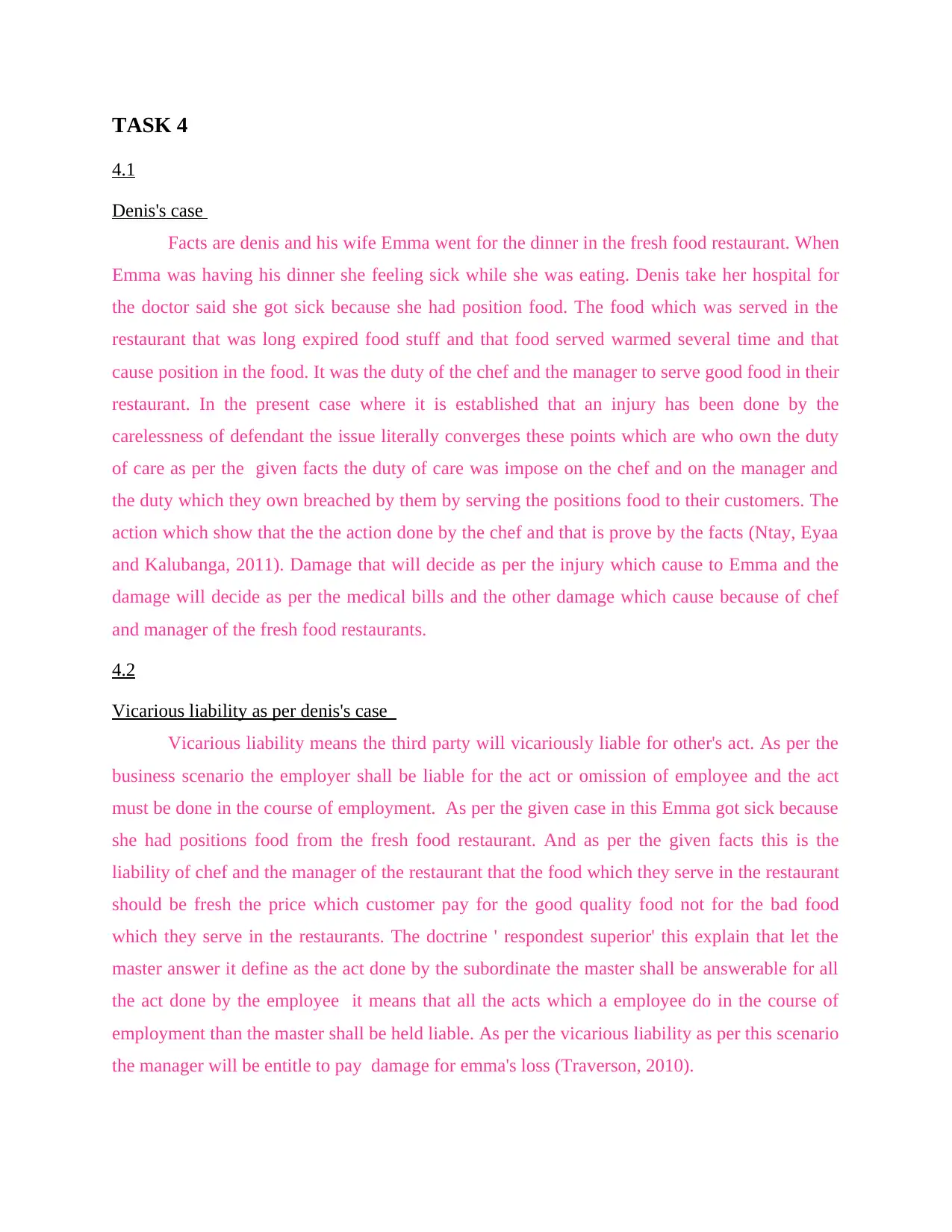
TASK 4
4.1
Denis's case
Facts are denis and his wife Emma went for the dinner in the fresh food restaurant. When
Emma was having his dinner she feeling sick while she was eating. Denis take her hospital for
the doctor said she got sick because she had position food. The food which was served in the
restaurant that was long expired food stuff and that food served warmed several time and that
cause position in the food. It was the duty of the chef and the manager to serve good food in their
restaurant. In the present case where it is established that an injury has been done by the
carelessness of defendant the issue literally converges these points which are who own the duty
of care as per the given facts the duty of care was impose on the chef and on the manager and
the duty which they own breached by them by serving the positions food to their customers. The
action which show that the the action done by the chef and that is prove by the facts (Ntay, Eyaa
and Kalubanga, 2011). Damage that will decide as per the injury which cause to Emma and the
damage will decide as per the medical bills and the other damage which cause because of chef
and manager of the fresh food restaurants.
4.2
Vicarious liability as per denis's case
Vicarious liability means the third party will vicariously liable for other's act. As per the
business scenario the employer shall be liable for the act or omission of employee and the act
must be done in the course of employment. As per the given case in this Emma got sick because
she had positions food from the fresh food restaurant. And as per the given facts this is the
liability of chef and the manager of the restaurant that the food which they serve in the restaurant
should be fresh the price which customer pay for the good quality food not for the bad food
which they serve in the restaurants. The doctrine ' respondest superior' this explain that let the
master answer it define as the act done by the subordinate the master shall be answerable for all
the act done by the employee it means that all the acts which a employee do in the course of
employment than the master shall be held liable. As per the vicarious liability as per this scenario
the manager will be entitle to pay damage for emma's loss (Traverson, 2010).
4.1
Denis's case
Facts are denis and his wife Emma went for the dinner in the fresh food restaurant. When
Emma was having his dinner she feeling sick while she was eating. Denis take her hospital for
the doctor said she got sick because she had position food. The food which was served in the
restaurant that was long expired food stuff and that food served warmed several time and that
cause position in the food. It was the duty of the chef and the manager to serve good food in their
restaurant. In the present case where it is established that an injury has been done by the
carelessness of defendant the issue literally converges these points which are who own the duty
of care as per the given facts the duty of care was impose on the chef and on the manager and
the duty which they own breached by them by serving the positions food to their customers. The
action which show that the the action done by the chef and that is prove by the facts (Ntay, Eyaa
and Kalubanga, 2011). Damage that will decide as per the injury which cause to Emma and the
damage will decide as per the medical bills and the other damage which cause because of chef
and manager of the fresh food restaurants.
4.2
Vicarious liability as per denis's case
Vicarious liability means the third party will vicariously liable for other's act. As per the
business scenario the employer shall be liable for the act or omission of employee and the act
must be done in the course of employment. As per the given case in this Emma got sick because
she had positions food from the fresh food restaurant. And as per the given facts this is the
liability of chef and the manager of the restaurant that the food which they serve in the restaurant
should be fresh the price which customer pay for the good quality food not for the bad food
which they serve in the restaurants. The doctrine ' respondest superior' this explain that let the
master answer it define as the act done by the subordinate the master shall be answerable for all
the act done by the employee it means that all the acts which a employee do in the course of
employment than the master shall be held liable. As per the vicarious liability as per this scenario
the manager will be entitle to pay damage for emma's loss (Traverson, 2010).
Paraphrase This Document
Need a fresh take? Get an instant paraphrase of this document with our AI Paraphraser
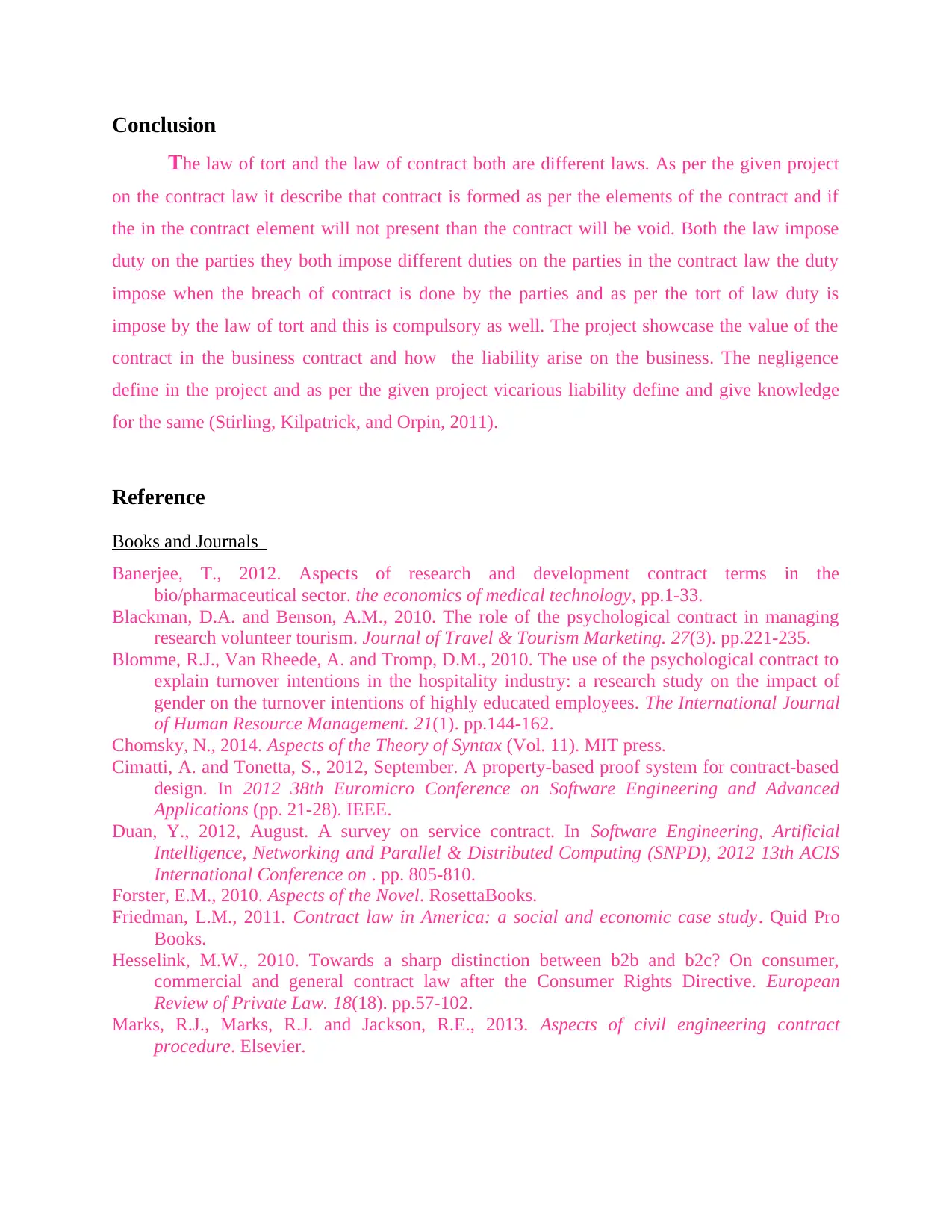
Conclusion
The law of tort and the law of contract both are different laws. As per the given project
on the contract law it describe that contract is formed as per the elements of the contract and if
the in the contract element will not present than the contract will be void. Both the law impose
duty on the parties they both impose different duties on the parties in the contract law the duty
impose when the breach of contract is done by the parties and as per the tort of law duty is
impose by the law of tort and this is compulsory as well. The project showcase the value of the
contract in the business contract and how the liability arise on the business. The negligence
define in the project and as per the given project vicarious liability define and give knowledge
for the same (Stirling, Kilpatrick, and Orpin, 2011).
Reference
Books and Journals
Banerjee, T., 2012. Aspects of research and development contract terms in the
bio/pharmaceutical sector. the economics of medical technology, pp.1-33.
Blackman, D.A. and Benson, A.M., 2010. The role of the psychological contract in managing
research volunteer tourism. Journal of Travel & Tourism Marketing. 27(3). pp.221-235.
Blomme, R.J., Van Rheede, A. and Tromp, D.M., 2010. The use of the psychological contract to
explain turnover intentions in the hospitality industry: a research study on the impact of
gender on the turnover intentions of highly educated employees. The International Journal
of Human Resource Management. 21(1). pp.144-162.
Chomsky, N., 2014. Aspects of the Theory of Syntax (Vol. 11). MIT press.
Cimatti, A. and Tonetta, S., 2012, September. A property-based proof system for contract-based
design. In 2012 38th Euromicro Conference on Software Engineering and Advanced
Applications (pp. 21-28). IEEE.
Duan, Y., 2012, August. A survey on service contract. In Software Engineering, Artificial
Intelligence, Networking and Parallel & Distributed Computing (SNPD), 2012 13th ACIS
International Conference on . pp. 805-810.
Forster, E.M., 2010. Aspects of the Novel. RosettaBooks.
Friedman, L.M., 2011. Contract law in America: a social and economic case study. Quid Pro
Books.
Hesselink, M.W., 2010. Towards a sharp distinction between b2b and b2c? On consumer,
commercial and general contract law after the Consumer Rights Directive. European
Review of Private Law. 18(18). pp.57-102.
Marks, R.J., Marks, R.J. and Jackson, R.E., 2013. Aspects of civil engineering contract
procedure. Elsevier.
The law of tort and the law of contract both are different laws. As per the given project
on the contract law it describe that contract is formed as per the elements of the contract and if
the in the contract element will not present than the contract will be void. Both the law impose
duty on the parties they both impose different duties on the parties in the contract law the duty
impose when the breach of contract is done by the parties and as per the tort of law duty is
impose by the law of tort and this is compulsory as well. The project showcase the value of the
contract in the business contract and how the liability arise on the business. The negligence
define in the project and as per the given project vicarious liability define and give knowledge
for the same (Stirling, Kilpatrick, and Orpin, 2011).
Reference
Books and Journals
Banerjee, T., 2012. Aspects of research and development contract terms in the
bio/pharmaceutical sector. the economics of medical technology, pp.1-33.
Blackman, D.A. and Benson, A.M., 2010. The role of the psychological contract in managing
research volunteer tourism. Journal of Travel & Tourism Marketing. 27(3). pp.221-235.
Blomme, R.J., Van Rheede, A. and Tromp, D.M., 2010. The use of the psychological contract to
explain turnover intentions in the hospitality industry: a research study on the impact of
gender on the turnover intentions of highly educated employees. The International Journal
of Human Resource Management. 21(1). pp.144-162.
Chomsky, N., 2014. Aspects of the Theory of Syntax (Vol. 11). MIT press.
Cimatti, A. and Tonetta, S., 2012, September. A property-based proof system for contract-based
design. In 2012 38th Euromicro Conference on Software Engineering and Advanced
Applications (pp. 21-28). IEEE.
Duan, Y., 2012, August. A survey on service contract. In Software Engineering, Artificial
Intelligence, Networking and Parallel & Distributed Computing (SNPD), 2012 13th ACIS
International Conference on . pp. 805-810.
Forster, E.M., 2010. Aspects of the Novel. RosettaBooks.
Friedman, L.M., 2011. Contract law in America: a social and economic case study. Quid Pro
Books.
Hesselink, M.W., 2010. Towards a sharp distinction between b2b and b2c? On consumer,
commercial and general contract law after the Consumer Rights Directive. European
Review of Private Law. 18(18). pp.57-102.
Marks, R.J., Marks, R.J. and Jackson, R.E., 2013. Aspects of civil engineering contract
procedure. Elsevier.

Molderez, T. and Janssens, D., 2012, March. Design by contract for aspects, by aspects. In
Proceedings of the eleventh workshop on Foundations of Aspect-Oriented Languages. pp.
9-14. ACM.
Ntay, J.M., Eyaa, S. and Kalubanga, M., 2011. Ethical culture of SMEs and perceived contract
enforcement in Ugandan buyer-supplier contractual arrangements. Eastern Africa Social
Science Research Review. 27(2). pp.51-90.
Peppet, S.R., 2011. Freedom of contract in an augmented reality: The case of consumer
contracts. UCLA L. Rev. 59. p.676.
Pierce, R., Stacey, K. and Wander, R., 2010. Examining the didactic contract when handheld
technology is permitted in the mathematics classroom. ZDM. 42(7). pp.683-695.
Pultrone, C., 2012. Overview of Contract Farming: Legal Issues and Challenges, An. Unif. L.
Rev., 17. p.263.
Riesenhuber, K., 2011. A Competitive Approach to EU Contract Law. European Review of
Contract Law. 7(2). pp.115-133.
Stirling, C., Kilpatrick, S. and Orpin, P., 2011. A psychological contract perspective to the link
between non-profit organizations' management practices and volunteer sustainability.
Human Resource Development International. 14(3). pp.321-336.
Traverson, B., 2010, October. Contract Management in Viewpoint Specifications: Experiment in
the Electrical Network and the SOA Domains. In 2010 14th IEEE International Enterprise
Distributed Object Computing Conference Workshops (pp. 361-367). IEEE.
Wills, B.A. and Napier-Munn, T., 2015. Wills' mineral processing technology: an introduction to
the practical aspects of ore treatment and mineral recovery. Butterworth-Heinemann.
Zhang, Q.F., 2012. The political economy of contract farming in China's agrarian transition.
Journal of Agrarian Change. 12(4). pp.460-483.
Online-
ACCA. 2016. [Online]. Available through; <http://www.accaglobal.com/uk/en/student/exam-support-
resources/fundamentals-exams-study-resources/f4/technical-articles/key-aspects-of-the-law-of-
contract-and-the-tort-of-negligence.html> .[ Accessed on 16th January 2017].
LawTeacher. 2017. [Online]. Available through;
<http://www.lawteacher.net/free-law-essays/tort-law/liability-in-negligence.php>. [ Accessed
on 16th January 2017].
Worksmart . 2016. [online]. Available through; < https://worksmart.org.uk/work-rights/pay-and-
contracts/contract-terminology/what-difference-between-implied-and-express-terms>.
[Accessed on 16th January 2017].
Proceedings of the eleventh workshop on Foundations of Aspect-Oriented Languages. pp.
9-14. ACM.
Ntay, J.M., Eyaa, S. and Kalubanga, M., 2011. Ethical culture of SMEs and perceived contract
enforcement in Ugandan buyer-supplier contractual arrangements. Eastern Africa Social
Science Research Review. 27(2). pp.51-90.
Peppet, S.R., 2011. Freedom of contract in an augmented reality: The case of consumer
contracts. UCLA L. Rev. 59. p.676.
Pierce, R., Stacey, K. and Wander, R., 2010. Examining the didactic contract when handheld
technology is permitted in the mathematics classroom. ZDM. 42(7). pp.683-695.
Pultrone, C., 2012. Overview of Contract Farming: Legal Issues and Challenges, An. Unif. L.
Rev., 17. p.263.
Riesenhuber, K., 2011. A Competitive Approach to EU Contract Law. European Review of
Contract Law. 7(2). pp.115-133.
Stirling, C., Kilpatrick, S. and Orpin, P., 2011. A psychological contract perspective to the link
between non-profit organizations' management practices and volunteer sustainability.
Human Resource Development International. 14(3). pp.321-336.
Traverson, B., 2010, October. Contract Management in Viewpoint Specifications: Experiment in
the Electrical Network and the SOA Domains. In 2010 14th IEEE International Enterprise
Distributed Object Computing Conference Workshops (pp. 361-367). IEEE.
Wills, B.A. and Napier-Munn, T., 2015. Wills' mineral processing technology: an introduction to
the practical aspects of ore treatment and mineral recovery. Butterworth-Heinemann.
Zhang, Q.F., 2012. The political economy of contract farming in China's agrarian transition.
Journal of Agrarian Change. 12(4). pp.460-483.
Online-
ACCA. 2016. [Online]. Available through; <http://www.accaglobal.com/uk/en/student/exam-support-
resources/fundamentals-exams-study-resources/f4/technical-articles/key-aspects-of-the-law-of-
contract-and-the-tort-of-negligence.html> .[ Accessed on 16th January 2017].
LawTeacher. 2017. [Online]. Available through;
<http://www.lawteacher.net/free-law-essays/tort-law/liability-in-negligence.php>. [ Accessed
on 16th January 2017].
Worksmart . 2016. [online]. Available through; < https://worksmart.org.uk/work-rights/pay-and-
contracts/contract-terminology/what-difference-between-implied-and-express-terms>.
[Accessed on 16th January 2017].
⊘ This is a preview!⊘
Do you want full access?
Subscribe today to unlock all pages.

Trusted by 1+ million students worldwide
1 out of 12
Related Documents
Your All-in-One AI-Powered Toolkit for Academic Success.
+13062052269
info@desklib.com
Available 24*7 on WhatsApp / Email
![[object Object]](/_next/static/media/star-bottom.7253800d.svg)
Unlock your academic potential
Copyright © 2020–2025 A2Z Services. All Rights Reserved. Developed and managed by ZUCOL.





